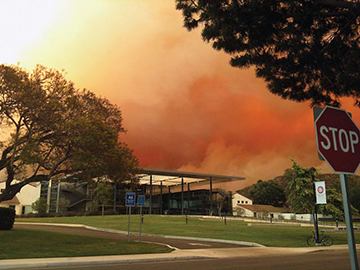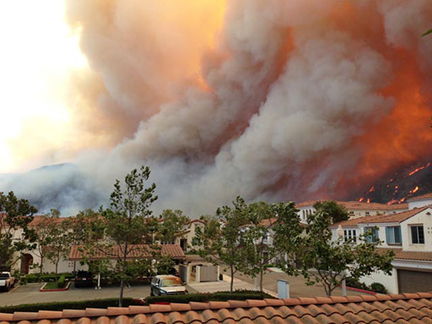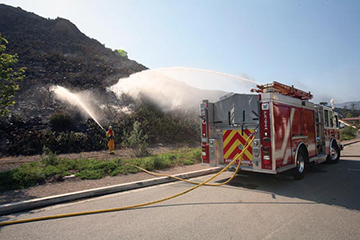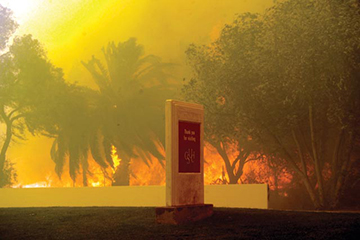Springs Fire—At the Ready
Preparation and Response Ensures Campus Safety
By A. Michael Berman, Vice President for Information Technology Services
Thick smoke overhead. Walls of flame racing down the slope behind Sage Hall. Fire trucks criss-crossing the campus. Pine bark sending up wisps of smoke as it ignites in planters around the new Central Mall.
Most days when I come to campus I don’t think too much about the emergencies that we might face. We spend some time planning for them, but we always hope they won’t come. But on that Thursday in May, things changed quickly.
On my drive in, I heard there was a fire closing lanes on the 101 freeway. As I got closer to Camarillo, I could see the smoke rising from the hills. But what really got me worried was the wind. It was not just blowing hard, it was swinging back and forth in dramatic gusts. And it was easy to see that the smoke pointed directly towards campus.
 photo courtesy of JASON MILLER
photo courtesy of JASON MILLERThe key leaders of Information Technology Services had just come together to make sure we were ready, when the call came—prepare to evacuate. After making sure everyone had left our offices in Solano Hall, I headed over to our Police Department to connect with Nancy Gill, Director of Communication & Public Relations, who was already fielding calls from news media and sending information messages to the campus community. The sky was a grim orange and black and ashes were falling onto the group. The day was hot and the wind fierce. And all the smoke was blowing straight towards us.
Within about an hour, all the students and most of the rest of the campus population had been evacuated. The senior campus leadership was gathered with our police officers and key staff members in the Emergency Operations Center. It was clear— this was not a drill. Flames were visible through the thick smoky air. I could feel the heat of the fire-driven wind waft across the campus. A few TV trucks darted about among the fire trucks.

But despite the roaring inferno surrounding the campus, the mood at the Emergency Operations Center was calm and professional. You could see that the firefighters had complete confidence in their ability to protect us, so it was impossible to doubt their resolve. It seemed almost as if a wall of protection surrounded the campus. Now and then a burning ember drifted onto the campus, and occasionally a small fire would start. When flames began to lift from burning vegetation on a roof, the fire fighters were there almost instantly, quenching the fire before it could take hold and do damage.
Among the lesser-known “first responders” were our Information Technology staff. While they don’t risk life and limb like fire fighters and police officers, they were no less determined to assure that our systems remained up and accessible so that we could communicate in an emergency. Working from home, they were able to execute our emergency plan which moved key online services to an off-campus location with little or no disruption. There were a few glitches, but through most of the emergency students and faculty could continue their work.

Rob Varela/VCSTAR
And then, after a couple of hours, things seemed almost normal, at least if you didn’t notice wisps of smoke wafting from the blackened hills or the smell of a barbecue gone mad.We don’t usually think about the web of support that underlies a campus—the dedicated groundskeepers that make sure that brush is cleared away; the University police constantly on patrol; the housing staff ready to get students off-campus in a flash without panic; and the dedicated professionals throughout the community who stand at the ready 24 hours a day. But you can bet all of us thought about them that Thursday, and we probably won’t forget for a long time.
